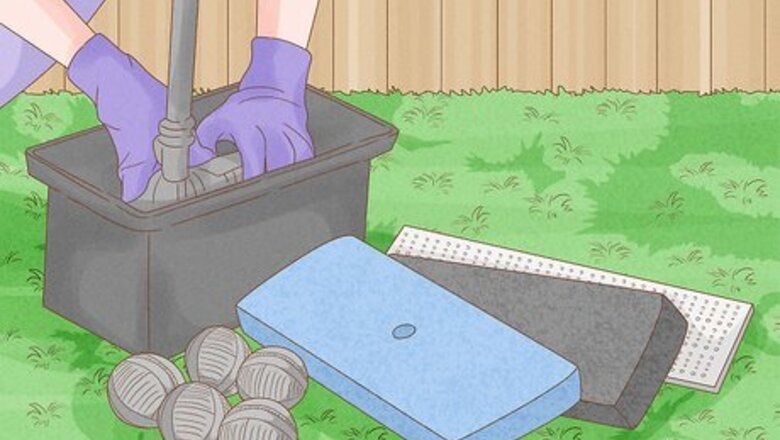
views
Performing Basic Pond Maintenance
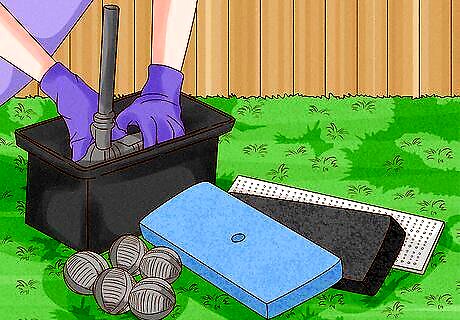
Clean your pump's filters out regularly. Most filters require cleaning once each week. Usually, cleaning is a simple matter of removing the filter, spraying it down with a hose, and replacing it. However, you should always follow the manufacturer's instructions when deciding how and how often to clean your filter. If you notice your pump leaking or struggling noisily, you probably need to clean it. If your filter has a gauge on it, clean it when the back-pressure reaches four to five pounds. Failure to clean your filter regularly will result in it working less efficiently, and leave your pond dirty.
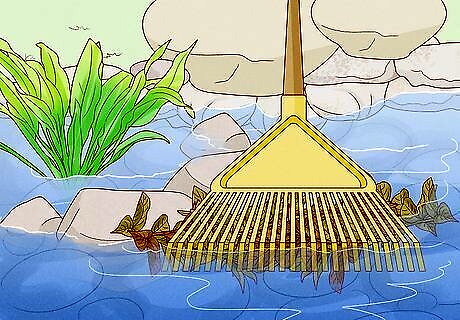
Manually clean your pond. The cheapest but most time-consuming method of removing algae is to go out each day, or every few days, and check for algae. If you see any, use a rake or a long stick to remove it directly from the water. If you choose to employ this method, you must be vigilant and check the pond on a regular basis. Remove leaves and debris floating on the water. Most leaves, twigs, seeds, and loose grasses can be removed with a pond skimmer, a kind of long-handled net specifically designed to keep ponds and pools clean. These are readily available at most home care stores. Clean the bottom of the pond. You can use a pond vacuum or a wet vacuum to clean the bottom. A pond vacuum is a device that allows you to suck up leaves, algae, sludge, and other debris that you don't want in the bottom of your pond. They are readily available at most home improvement stores.
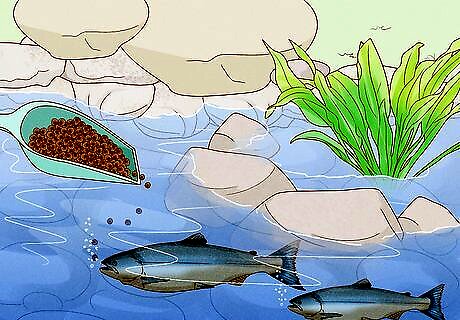
Feed your fish properly. Feeding your fish properly involves choosing the right feed and feeding in the right amounts. If you have fish in your pond, selecting a high-quality fish feed will prevent the growth of algae, as the food will be more fully digested, and your fish will produce less waste. In order to ensure your fish eat all the food they're given, check for food floating on the surface about twenty minutes after you're done feeding them. If you see food bits still floating in the water, you'll know that you're overfeeding and should gradually reduce the amount of feed you're providing to a level where you do not see feed floating on the surface after feeding is complete. Excess food will rot and give algae nutrients it can use to grow. The type of feed you choose to give your fish depends on the species, though most commercially available feeds are appropriate for multiple species. Talk to the proprietor of your local pet store or your vet if you have questions about what type of feed is best for your fish. Reduce the amount of feed you give your fish in autumn and winter. During these seasons, their metabolism slows and they'll require less food.
Using Organic Matter to Keep Your Pond Clean
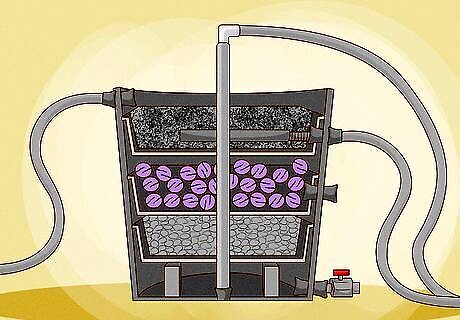
Use a biological filter. A biological filter uses bacteria to remove organic waste that can accumulate in your pond. You could get an in-pond filter or an external filter. In-pond filters have a pump attached to a fountain that runs into the pond. While they are easy to setup and install, they are difficult to clean because you must remove the entire contraption from the pond. External filters are very easy to clean, but it can be difficult to get the right size and pump, since they are usually designed for pools, not ponds. While these bacteria occur naturally in ponds, they are not present in the quantities necessary to adequately filter all the toxins that occur in most ponds. Get a filter capable of filtering about twice the amount of water that our pond contains. For instance, if a filter says it can adequately filter 3,000 liters, you should use it only if your pond is around 1,500 liters or less. If you get a filter that matches your pond's volume exactly, it will struggle to keep the pond clean. Your filter should filter your entire pond in about two hours. Check the speed of the pump and compare it to your pond's volume to choose the right one.
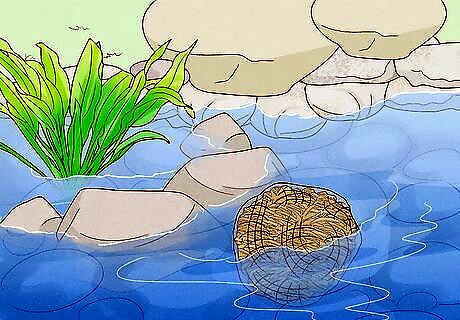
Add barley straw to your pond. As barley straw decomposes, it releases a chemical that prevents algae from growing. One bale of barley straw treats 1,000 gallons of water. In other words, if your pond holds 100 gallons, you'd need only one-tenth of a bale. The best way to add the straw is to wrap a softball-sized portion of straw in mesh netting and toss the balled-up straw in the pond. Alternatively, you could add liquid barley straw. One tablespoon usually treats about 50 gallons. If you don't notice a change after about a week, add more gradually. Barley straw is readily available at most garden centers. Barley straw is safe for use in ponds with fish. EXPERT TIP Maggie Moran Maggie Moran Home & Garden Specialist Maggie Moran is a Professional Gardener in Pennsylvania. Maggie Moran Maggie Moran Home & Garden Specialist Barley straw is great for preventing murky water. Horticulturalist Maggie Moran explains, “One of the biggest reasons that pond water becomes murky is due to the growth of algae. Using barley straw is an easy and effective way to prevent algae from growing and keep the water clear.”
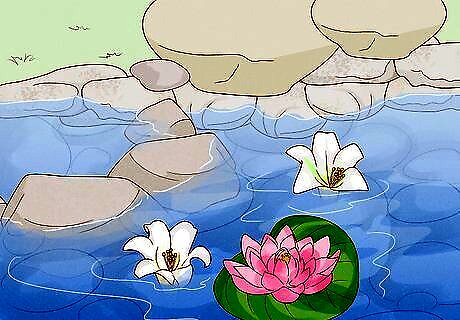
Add plants to the pond. You could add both floating plants and submerged plants to your pond. Both will keep algae at bay and keep your pond clean in a natural way. Add floating plants. Lilies and lotus reduce the total surface area of the pond that algae can thrive on, and absorb nutrients that algae would otherwise use to grow. Submerged plants like hornwort, parrot's feather, and anacharis add oxygen to the water, preventing algae. They can be kept below the water's surface by attaching them to a rock or putting them in a plant pot and adding weight until it sinks.
Keeping Your Pond Clean Through Artificial Means
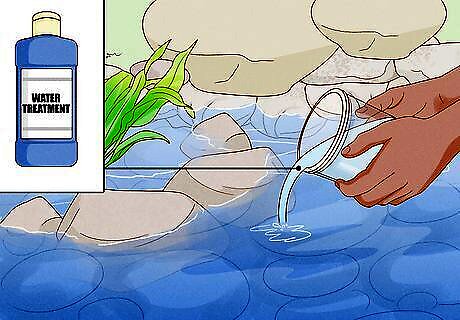
Add water treatments. Water treatments are chemical formulas designed to block or remove algae. They are typically safe for use with fish and invertebrates like snails, but will harm tadpoles. Specific directions for use vary with the particular product you choose to use in your pond. Always follow manufacturer directions when adding water treatments to your pond. Water treatments will need to be reapplied from time to time, so just add more as necessary when you notice algae or green water.

Add calcium sulfate. Calcium sulfate, also known as gypsum, is useful for breaking up pond sludge that accumulates at the bottom of the pond. Sprinkle the calcium sulfate evenly across the surface of the pond at a concentration of 525 pounds per acre-foot of water. Calcium sulfate is readily available at most gardening centers. Calcium sulfate will not harm your fish or pond plants.
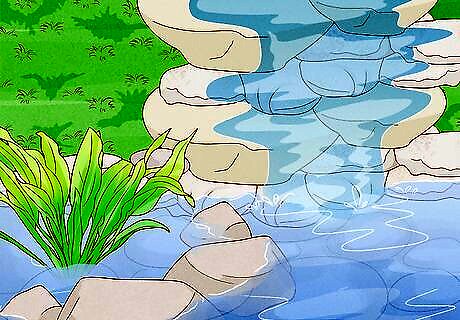
Introduce a moving water fixture. With moving water, your pond will be less likely to accrue algae and grime. You could add a fountain or waterfall to your pond. With either fixture, ensure it is placed next to the pond so that water will return to it. Fountains could be placed in the middle of the pond if the pond's depth does not exceed the height of the fountain. If you install a fountain or waterfall less than three feet high, the pump should be located next to the waterfall on the ground level. If you install a waterfall five feet tall or taller, the filter should be placed just behind the waterfall at an elevation equal to its highest point.
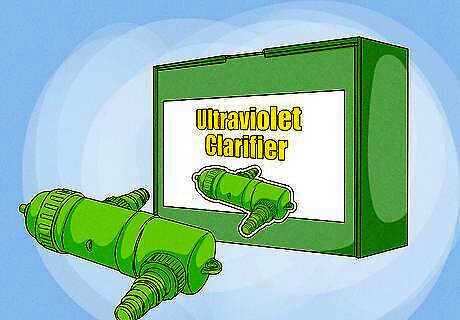
Get an ultraviolet (UV) clarifier. UV clarifiers are special pumps that pull pond water into a chamber where the water is exposed to ultraviolet light. The light kills suspended algae (but not string algae) in the water and allows you to easily remove any algae detritus. UV clarifiers can be attached to either mechanical or biological filters. UV light is harmful to human eyes, so the UV bulb will be situated within a case. Do not disassemble or remove the case from the UV clarifier. A clarifier with 8-10 watts of UV light is appropriate for 1,000 gallons of water.
Emptying the Pond for Deep Cleaning
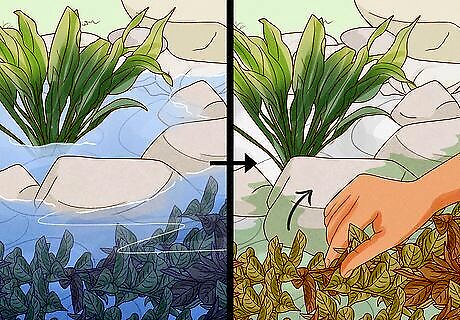
Decide when a deep cleaning is necessary. If there are many dead leaves and a lot of sludge at the bottom of the pond that you can't easily remove with a pond vacuum, you'll need to empty the pond entirely. If you can easily remove debris at the bottom of the pond, a complete cleaning is not necessary. You should empty and deeply clean your pond at least once a year. The best times to do this are in the spring (so you can remove debris that accumulated during winter) and in the fall (when you're getting ready to winterize your pond).

Pump water out of the pond. You can buy or rent a water pump from most home improvement stores. Ensure the pump has a long extended hose or handle so the pump will reach to an appropriate depth in your pond. To avoid wasting the water, direct it to a garden at the back of your house or to the lawn. Place some of the pond water in a large tub, inflatable swimming pool, or other large container if you have fish. This water will serve as your holding tank for your fish while the pond is empty.
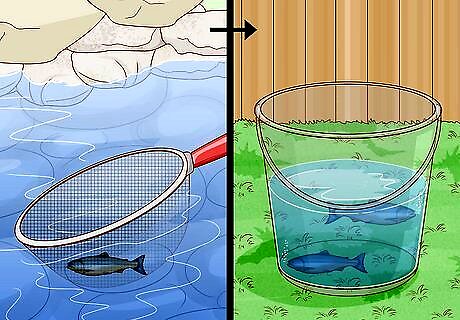
Remove your fish. After you've removed most of the water from the pond, transfer your fish to the holding container(s). The water level should be high enough that the fish can still swim around, but low enough that you can walk easily in it. Water of about a half-meter in depth is a good level at which to remove the fish. Remove your fish with a fish net. Scoop the fish out and place them in the container holding pond water you filled earlier. You might need to place netting or mesh over the container holding the fish to ensure they don't leap out.
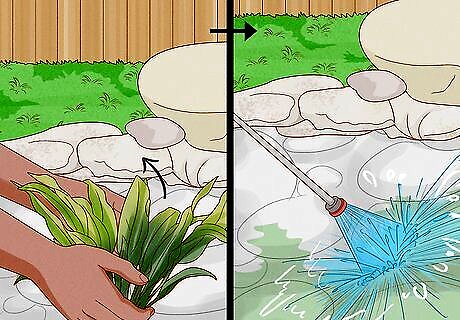
Finish emptying the pond. Once the pond is empty, begin removing the aquatic plants from the pond. If any of the plants need water to survive, put them in a holding tank. Scoop up and remove any dead plants or plant material. Clean the pond while it is empty. Wash the grime from the bottom and sides of the pond with a pressurized water spray gun. Don't use bleach or any toxic chemicals on your pond.
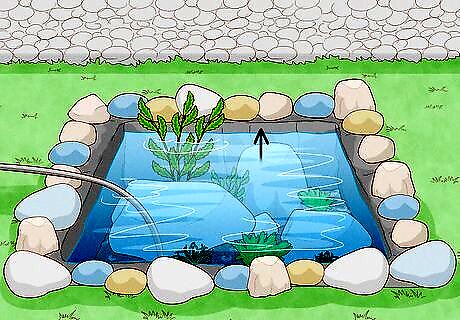
Refill the pond. Fill the pond up with clean water. Add a dechlorinating agent to the water. Dechlorinator is a solution designed to remove chlorine from water that comes out of your hose. This is important because chlorine in the water will kill fish. Replace your plants and fish in the pond. Dechlorinators are readily available at most pet stores. The amount you need will depend on the size of your pond. Consult manufacturer directions for specific use. To acclimate your fish to the new water, take one gallon of water out of the holding tank and add about one gallon of the new pond water to it every five minutes. After about 30 minutes, transfer the fish back into the pond.















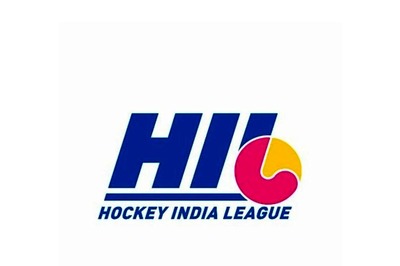

Comments
0 comment